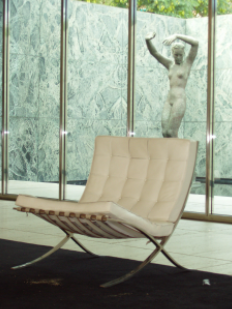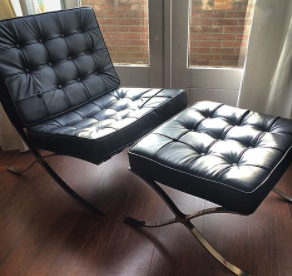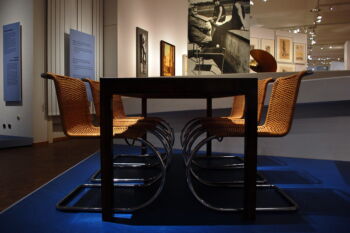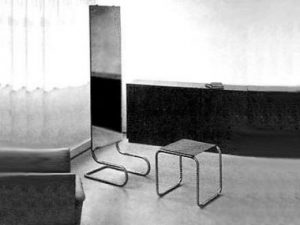German modernist designer and visual artist Lilly Reich was the first woman elected to the governing board of the Deutscher Werkbund. She is best known for designing the Barcelona Chair.

Image source: https://en.wikipedia.org/wiki/Lilly_Reich#/media/File:Lillyreich04.jpg
Reich’s Life
Lily Reich was born in 1885, in Berlin. She started to design furniture and clothing when she 26 years old, while working a shop window decorator. In 1920, Lilly became the first woman accepted among members of the board of the Deutscher Werkbund, which was a prestigious German Design and Architecture institution. During one of their trade fairs, Reich met fellow architect Ludwig Mies Van der Rohe, who became her close collaborator, both on the job and in their private lives. Together, they co-designed various furniture pieces such as the Barcelona chair and table. Despite this, unfortunately, Reich never reached the same popularity as her male counterpart. Then, in 1932, she taught at the Bauhaus art and design school, acting as head instructor of the interior design workshop. However, just the following year, the Bauhaus school closed, under political pretenses, by the Nazi party. After the end of the II World War, Reich taught again, but passed away in 1947.

Image source: https://commons.wikimedia.org/wiki/File:Pavell%C3%B3_Mies_06.JPG
Her Rise to Fame
Like several other European modernists during the 1920s, Reich had a strong interest in combining new, industrial production techniques with high-tech, functional materials. Further, this led her to be the only woman of that time to design a full furniture set. Since her early years, she displayed interest in embroidery. However, she only began to apply her knowledge and skills on the subject to Bauhaus-related projects in 1908. Her claim to fame, due to the design’s popularity, was the creation, together with Ludwig Mies van der Rohe, of the famous Barcelona chair. Although the latter took most of the credit for its inception and creation, many believe that the design was strongly influenced by Reich. The exclusive rights for the manufacture and sale of the Barcelona Chair were granted to the Knoll industry in 1953. Similarly to many other iconic design pieces of the time, many reproductions still circulate today.

Image source:https://search.creativecommons.org/photos/c7fee43d-fd87-405d-ac15-af9fbb4029cc by GuySie
However, the chair was not her only contribution to the genre. Additionally, Reich designed a cooking cupboard for the 1931 German Building Exhibition, The Dwelling in our Time, in Berlin. With this piece, she aimed to show how functionality could be both beautiful and powerful without sacrificing form or function. The piece has a closet-like appearance once closed. However, once opened, a sink, shelves, drawers and several kitchen tools can be seen, thus filling a new niche in the kitchen space. Today, the design can be seen at MOMA, or the Museum of Modern Art in NYC.

Image source:https://www.flickr.com/photos/suburbanslice/4687187499 byMatthew Benjamin Colema
Features of Her Style
!["Weißenhof chair", by Mies van der Rohe with canework upholstery by Reich[1] (ca. 1927).](https://www.idesign.wiki/wp-content/uploads/2021/12/Immagine-2021-12-22-130449.png)
Image source: https://en.wikipedia.org/wiki/Lilly_Reich#/media/File:Wei%C3%9Fenhof-Stuhl_mit_Geflecht_von_Lilly_Reich.jpg
Lilly Reich specialized in fabrics and clothes. Between 1916 and 1917, during the war, she opened a small tailoring shop and sold models designed by her. Further, one of her most important traits was the simplicity as a way to ensure her creations remained timeless. In addition, she adopted what she perceived as an essential design and never gave up a minimalist and elegant taste. In 1922, in a publication on fashion for the “Die Form” magazine, she proposed a new way of dressing, sober and free of adjectives and past labels
Her philosophy ensured her design for the Barcelona chair remained one of the most recognizable lounge chairs in the world, for both private and public environments. Additionally, this showcased her strong talent and innovative approach, which is praised even a century later.

Image source: https://www.bauhaus2yourhouse.com/products/lilly-reich-pier-mirror
Info sources:
